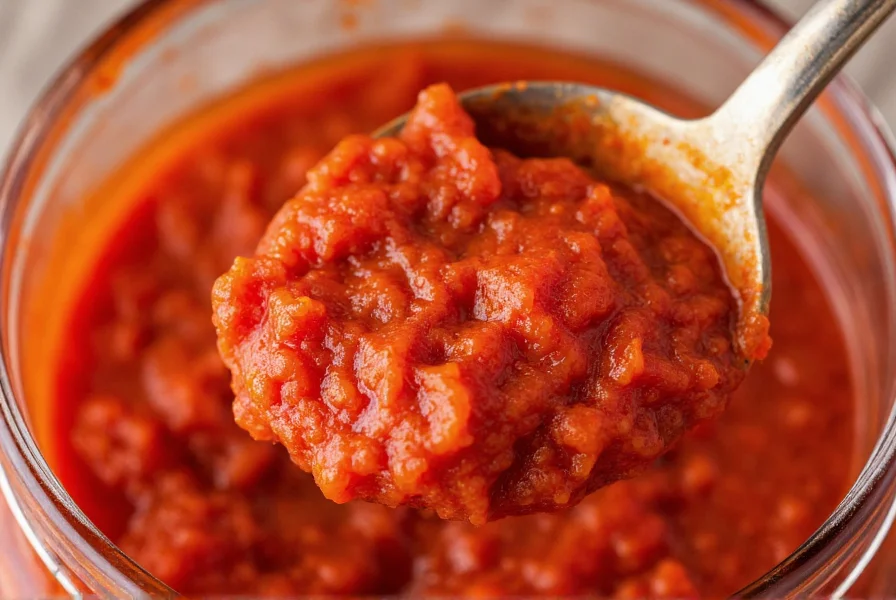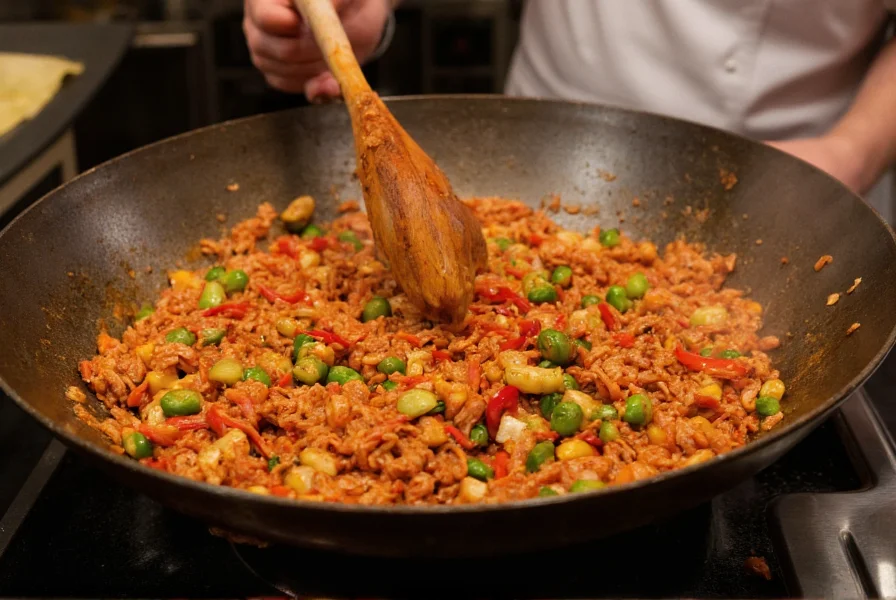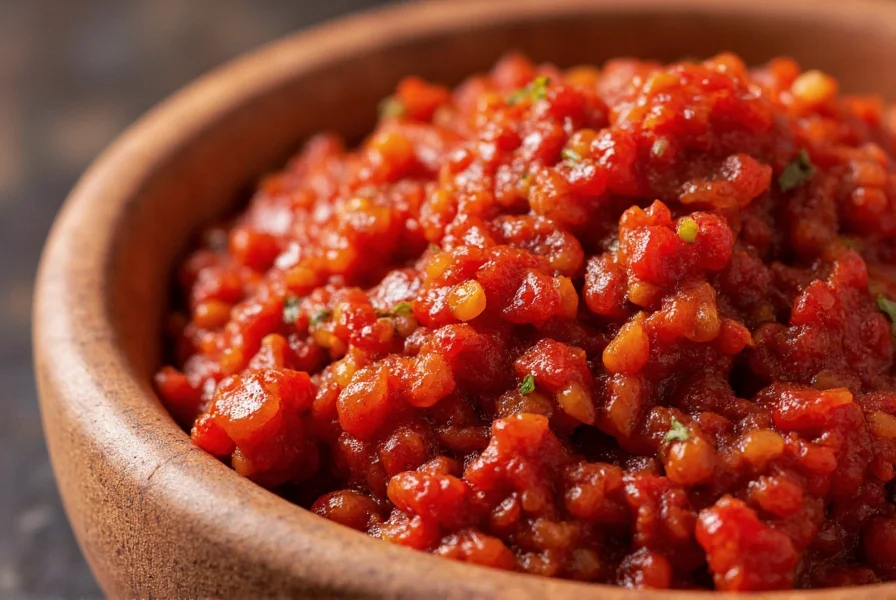Understanding how to use red chili paste effectively transforms your cooking. This concentrated ingredient provides immediate depth and heat, eliminating the guesswork of chopping fresh chilies. Whether you're stir-frying, braising, or creating dipping sauces, a small amount delivers big flavor. The paste's vinegar content also acts as a natural preservative while adding subtle tanginess to balance rich dishes.
What Exactly Is Red Chili Paste?
Red chili paste consists primarily of ripe red chilies processed into a smooth or slightly textured puree. Commercial varieties typically include vinegar for preservation and pH balance, salt for flavor enhancement, and occasionally garlic or sugar. The Scoville heat units vary significantly by brand and region—from mild Korean gochujang (1,500-2,500 SHU) to fiery Thai nam prik pao (20,000+ SHU).
Unlike fresh chilies where heat distribution can be uneven, red chili paste ensures consistent spiciness throughout your dish. The grinding process releases capsaicin oils more completely than chopping, creating a more integrated flavor profile. This makes it particularly valuable for sauces and marinades where uniform heat distribution matters.

Red Chili Paste vs. Similar Products
Many cooks confuse red chili paste with other chili-based products. Understanding these differences prevents recipe mishaps:
| Product | Texture | Key Ingredients | Best Uses |
|---|---|---|---|
| Red chili paste | Smooth puree | Red chilies, vinegar, salt | Soups, braises, marinades |
| Sambal oelek | Coarse, chunky | Fresh red chilies, vinegar, salt | Stir-fries, dipping sauces |
| Chili garlic sauce | Chunky with visible garlic | Red chilies, garlic, vinegar | Asian-American dishes |
| Gochujang | Thick, sticky paste | Chilies, fermented soybeans, rice | Korean BBQ, stews |
Regional Variations and Their Culinary Applications
Red chili paste appears in numerous cultural variations, each with distinctive characteristics:
- Asian varieties: Thai nam prik pao contains shrimp paste and tamarind for complex umami notes, perfect for pad kra pao. Chinese la jiang offers pure heat without additional flavors, ideal for mapo tofu.
- Latin American styles: Mexican recado rojo blends annatto with chilies for cochinita pibil, while Peruvian aji panca paste provides smoky sweetness for stews.
- Middle Eastern options: Harissa from North Africa features roasted red peppers and spices like caraway, essential for tagines and merguez sausage.
When selecting red chili paste for international recipes, match the regional variety to maintain authentic flavor profiles. Substituting Korean gochujang in a Thai curry, for example, introduces unwanted sweetness from fermented soybeans.
Mastering Red Chili Paste in Your Cooking
Professional chefs leverage red chili paste through these techniques:
- Bloom in oil: Heat 1-2 teaspoons in cooking oil for 30 seconds before adding other ingredients. This unlocks volatile flavor compounds and mellowes raw heat.
- Balancing acidity: The vinegar in most commercial pastes means you may need less additional acid in your recipe. Taste before adding extra citrus or vinegar.
- Layering heat: Add paste early for integrated warmth, or later for brighter, sharper heat. For complex dishes, use both methods—some at the beginning, some at the end.
- Marinade magic: Combine with oil, acid, and aromatics for meats. The paste's consistency helps it adhere better than fresh chilies.

Storage Guidelines for Maximum Freshness
Proper storage preserves flavor and prevents spoilage:
- Unopened commercial jars remain shelf-stable for 18-24 months in cool, dark places
- Refrigerate after opening—most varieties last 6-8 weeks
- Prevent cross-contamination by using clean utensils each time
- Freeze in ice cube trays for longer storage (up to 6 months)
- Discard if mold appears, smell turns sour, or color fades significantly
Simple Homemade Red Chili Paste Recipe
Create customizable paste with this basic formula:
- Roast 10-12 dried arbol or guajillo chilies until fragrant (2-3 minutes per side)
- Soak in hot water for 20 minutes until soft
- Drain and blend with 2 garlic cloves, 1 tsp vinegar, 1/2 tsp salt, and 1/4 cup water
- Adjust consistency with additional water as needed
- Store in sterilized jar with 1/4 inch oil layer on top
Variations: Add toasted cumin seeds for Mexican-style, fish sauce for Thai, or miso paste for umami depth. Homemade versions lack preservatives, so refrigerate and use within 2 weeks.
Frequently Asked Questions
Can I substitute red chili paste for fresh chilies?
Yes, but adjust quantities carefully. Substitute 1 teaspoon red chili paste for 1 medium fresh chili. Remember that paste delivers more consistent heat without the variable seeds and membranes of fresh chilies. Start with less than you think you need—you can always add more.
Why does my red chili paste separate in the jar?
Separation occurs naturally as oils rise to the top. This indicates no artificial stabilizers were added. Simply stir thoroughly before use. If the paste appears dry after stirring, mix in a few drops of warm water to restore consistency.
How can I reduce the heat level of red chili paste in a dish?
Balance excessive heat with dairy (yogurt or coconut milk), sweetness (honey or sugar), or starch (potatoes or rice). Acidic ingredients like lime juice can also help counterbalance spiciness. For future reference, bloom the paste in oil first—it reduces perceived heat by 20-30% while maintaining flavor.
Is red chili paste gluten-free?
Most traditional red chili paste varieties are naturally gluten-free, containing only chilies, vinegar, and salt. However, always check labels as some commercial brands add thickeners or flavor enhancers containing gluten. Korean gochujang typically contains rice but may use wheat in some formulations, so verify specifically for that variety.











 浙公网安备
33010002000092号
浙公网安备
33010002000092号 浙B2-20120091-4
浙B2-20120091-4